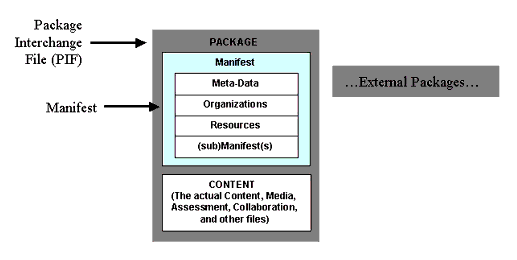IMS Content Packaging: Difference between revisions
m (→References) |
|||
| Line 27: | Line 27: | ||
* In more technical terms: E.g. the IMS Simple Sequencing binding defines a unique namespace for sequencing elements in such a way as to permit these elements to be embedded within an IMS Content Packaging manifest file. Elements in the Simple Sequencing namespace can be considered as extending the functionality of Content Packaging to included additional sequencing information. Simple Sequencing elements are intended to be included in the <organization> element of Content Packaging, which contains items that may be recursively included to create hierarchical trees of items. This tree corresponds to the activity tree that drives sequencing. | * In more technical terms: E.g. the IMS Simple Sequencing binding defines a unique namespace for sequencing elements in such a way as to permit these elements to be embedded within an IMS Content Packaging manifest file. Elements in the Simple Sequencing namespace can be considered as extending the functionality of Content Packaging to included additional sequencing information. Simple Sequencing elements are intended to be included in the <organization> element of Content Packaging, which contains items that may be recursively included to create hierarchical trees of items. This tree corresponds to the activity tree that drives sequencing. | ||
Here is a picture taken from the | Here is a picture taken from the [http://www.imsglobal.org/content/packaging/cpv1p1p4/imscp_bestv1p1p4.html IMS Content Packaging Best Practice and Implementation Guide Version 1.1.4] of october 2004 that shows an overview of the Package Interchange File (PIF) architecture: | ||
[[Image:IMS_Content_Packaging_1_1.gif]] | [[Image:IMS_Content_Packaging_1_1.gif]] | ||
Revision as of 17:06, 3 November 2006
Definition
IMS Content Packaging has the following objectives:
- allow transfer of e-learning contents from one system to an other (interoperability)
- allow to import/export contents into/from a [learning management system]. Therefore also be able to use an independent editing tool.
Content Packaging is an evolving standard. Make sure that you know what version you plan to build / import / export !!
- IMS Content Packaging 1.1 is also part of ADL/SCORM 1.2 and 1.3 (2004)
- ToDo: Specify which minor versions 1.1.*
Content packs are a kind of learning object.
Package architecture
A Package Interchange File (PIF) is a zip file (recommended, other formats are also allowed):
- File resources, e.g. HTML pages, pictures, Flash Animations, PPT (whatever, the idea is that you take formats that your client can handle). Organization in sub-directories is allowed.
- A special file in the zip is imsmanifest.xml containing:
- a meta-data section <metadata />: describes the package as a whole.
- a resource list <resources />: containing references to all of the actual resources and media elements needed for a manifest (files), including meta-data describing these resources, and references to any external files (URLs).
- an organizations section: describing zero, one, or multiple organizations of the content within a manifest, i.e. information that is used to "play" the contents.
- (sub)manifests, that can do the same for subpackages.
- The manifest, i.e. its organization section can contain IMS Simple Sequencing or IMS Learning Design instructions or other future standards.
- In more technical terms: E.g. the IMS Simple Sequencing binding defines a unique namespace for sequencing elements in such a way as to permit these elements to be embedded within an IMS Content Packaging manifest file. Elements in the Simple Sequencing namespace can be considered as extending the functionality of Content Packaging to included additional sequencing information. Simple Sequencing elements are intended to be included in the <organization> element of Content Packaging, which contains items that may be recursively included to create hierarchical trees of items. This tree corresponds to the activity tree that drives sequencing.
Here is a picture taken from the IMS Content Packaging Best Practice and Implementation Guide Version 1.1.4 of october 2004 that shows an overview of the Package Interchange File (PIF) architecture:
Run Time environments
Usually a Content Package is imported into a Learning management system, but there are also external players handy for platform independent authoring or even for off-line viewing (e.g. the "reload player"). The IMS specification refers to these systems as Learning technology system (LTS)
In principle (and this is where certain LMS make wrong claims about IMS/Scorm compatibility), an IMS Content is not just displayed, but it also should also interpret standards like [[IMS Simple sequencing] and support user tracking, conditional access to resources, let the user choose between different organizations, remember where the user was last time he accessed contents.
[In fall 2005, DKS tried to import IMS Packages found on the Web or made with Reload into some open source systems ... and was quite dismayed by the result ... ]
Tools
Editors:
- http://www.reload.ac.uk/tools.html (editor and player, make sure to pick the correct tool, i.e. don't get the Learning design tools !. These tools need Java)
- http://exelearning.org/ (based on the Mozilla toolkit).
- Authorware (version 7+)
See also: Learning management systems.
